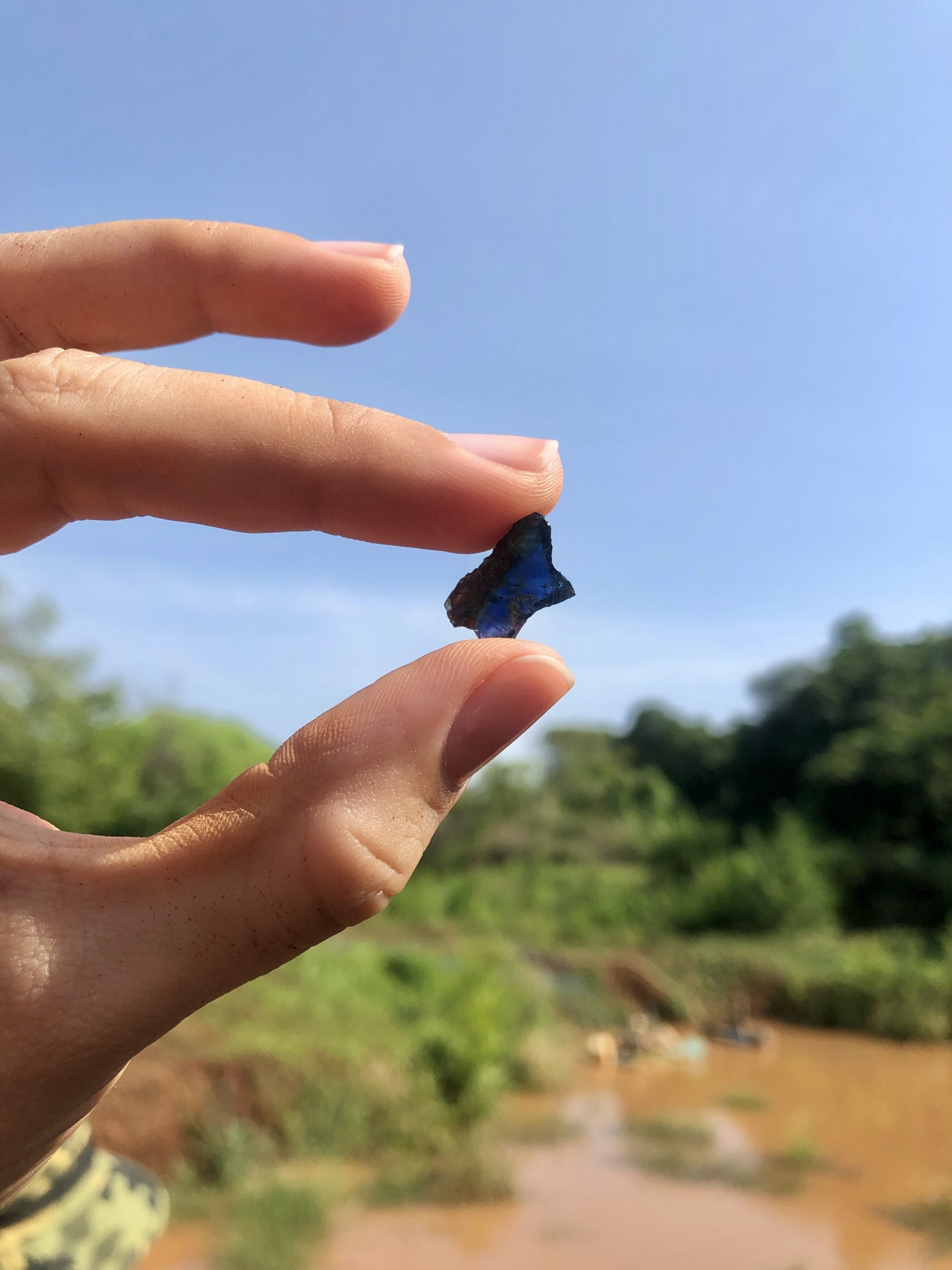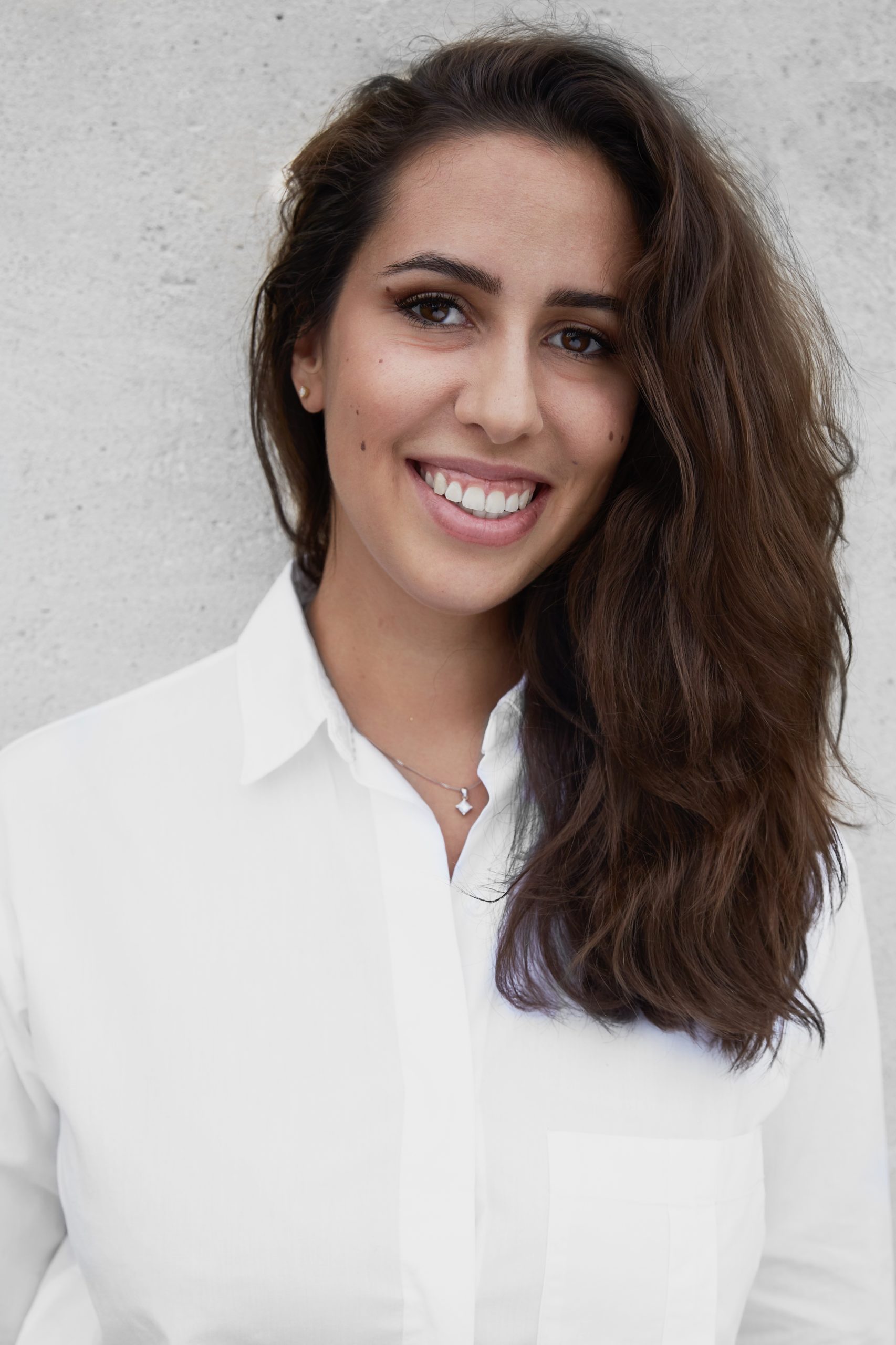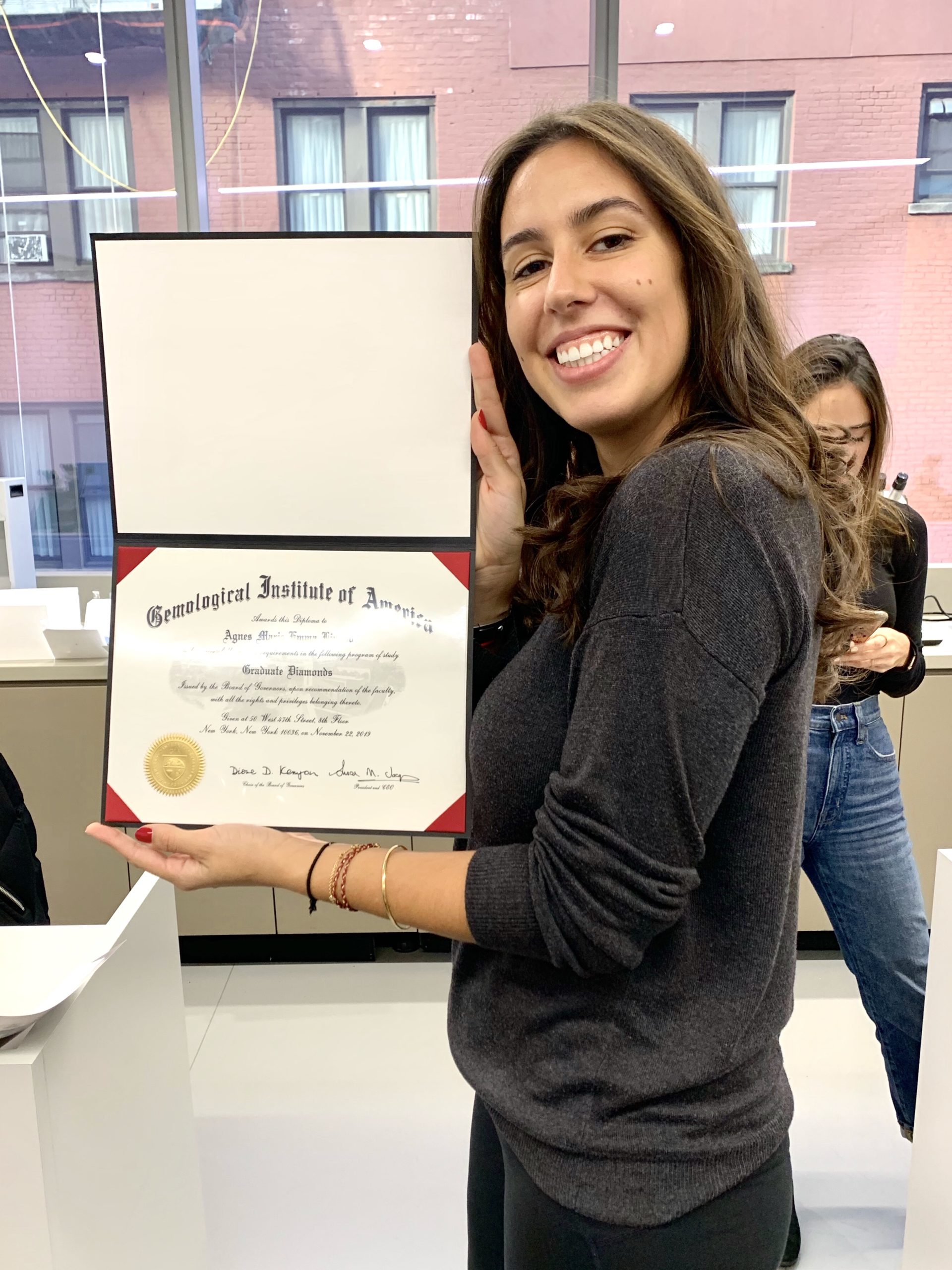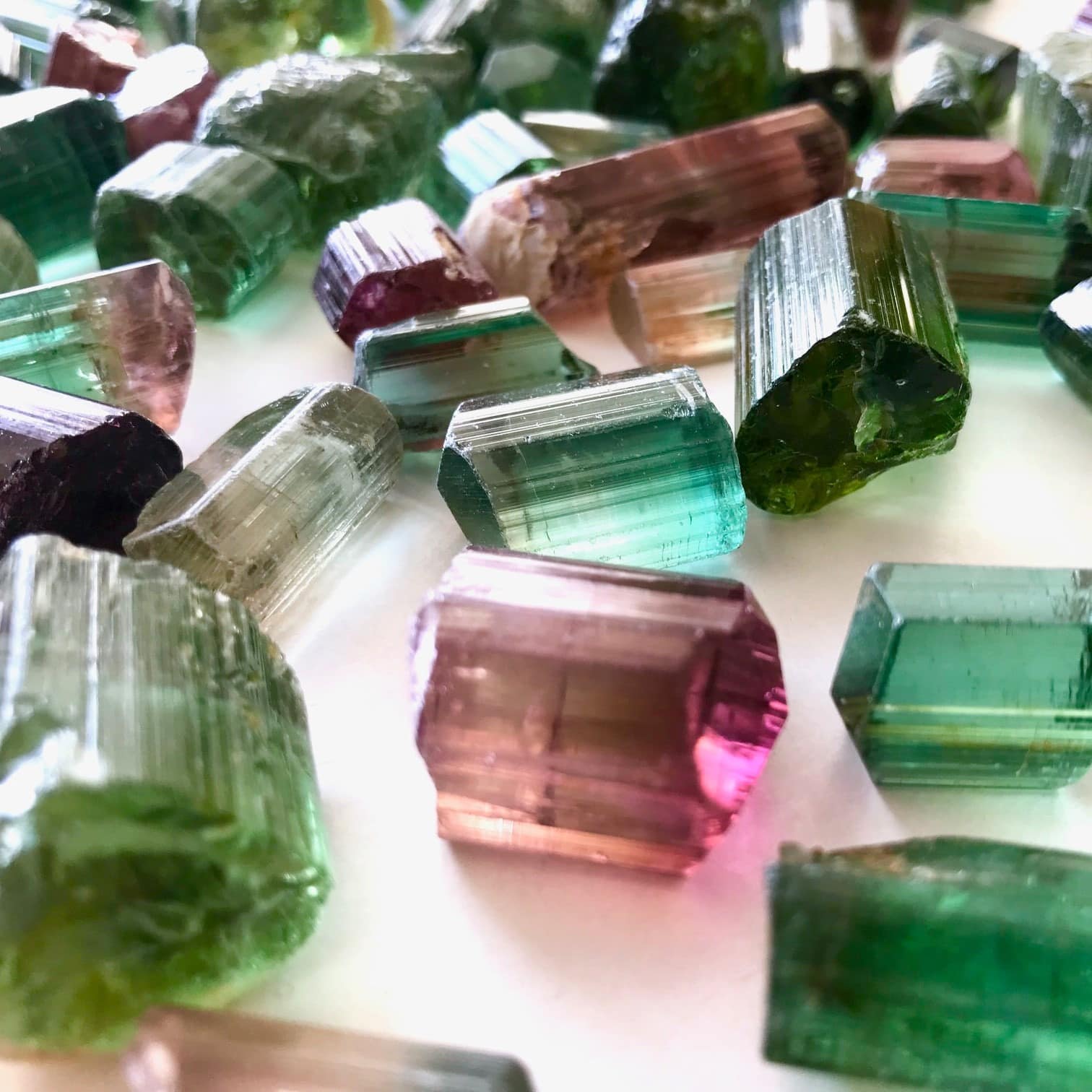I met Agnès a few years ago at a conference at the French Gemological Laboratory where she was working at the time. She was about to leave for London to meet her family and settle down again to work. I wanted to ask her to tell us about her life in London and what it’s like to be a gemologist there? Meet him!
Agnes Emma Limido
1- Hello Agnes, can you introduce yourself?
My name is Agnes, I am a 27 year old gemologist based in London. After working in several different industries, I decided to give gemology a shot and start exploring what I am passionate about, gemstones and diamonds!
2- When you were a child, what did you want to be when you grew up?
My first dream job was to be a beekeeper! Unfortunately for me, I soon discovered that I was allergic to them… I was already curious about minerals and fossils at a very young age. My grandfather, who was a physicist and especially a nature lover, encouraged me and increased my interest.
3- And finally, what is your current work?
I currently work for Taylor & Hart, a UK-based online retailer that focuses on bespoke bridal jewellery . My role is sales orientated and I lead the team of diamond and gemstone specialists.
4- What is your background?
I was born and raised in Paris. Just before I was 15, my family moved to London – which we now call home. Before going into gemology, I worked in Paris and Beijing for my family. I have been involved in property projects and a few different businesses (such as renewable energy, football, leather manufacturing, etc.).
5- What is your background in jewellery and gemology?
A few years after graduating from university, I decided that I wanted to do something that I was passionate about every day. To do this, I realised that I needed to pursue my passion for gems. After studying at the National Gemmological Institute, I was offered to join the French Gemmological Laboratory as an intern. At the beginning, my tasks were quite repetitive, such as weighing and photographing all the gems. After a few months, my internship turned into a real contract and I started to be trained by my very talented (and patient!) colleagues to do basic analysis with laboratory equipment. It is an incredible memory! Imagine all those beautiful and mesmerizing gems from high jewellery pieces…! The experience I gained there was invaluable and I still feel privileged today to have been able to work with such passionate and knowledgeable gemologists. (I can’t talk about it any longer!). In order to further my academic knowledge and expand my opportunities internationally, I joined the GIA Graduate Gemologist programme. As usual, I don’t like to do things in order… so I started with coloured stones in Bangkok! There I was able to walk around gem markets and visit mines. My experience was very rewarding both academically and personally. Once I graduated, I moved on to the diamond portion of the course which I took at their New York campus. The location on 47th Street in the diamond district was ideal for meeting people in the industry. I was able to navigate the business and spend time ‘behind the scenes’ with some of the top diamond dealers.
A sapphire found in Thailand. Photo: Agnès Emma Limido
6- Can you tell us more about your career choice and how you got to your current position?
It’s important for me to remember that gemology is the study of gemstones… that are intended to be set in jewellery. Although I love inspecting inclusions in minerals, I wanted to get closer to the consumer side of things. For this reason, I feel very lucky to have joined the company I am currently working for. Through word of mouth, I was introduced to someone who works for them and he sold me on the company in the best possible way. After a few interviews, I joined them… just before the great pandemic hit us!
7- So now you work in gems. Can you tell us about your company and its history?
Taylor & Hart is a start-up that is changing the way people buy engagement rings. It was created by two friends who wanted to create something truly unique for every couple looking to design a ring for their engagement. The original idea was to fill a gap in the market where bespoke designs were mostly unavailable. Not only do you have the option of designing your ring from scratch, but you can also choose to use Fairtrade gold or recycled platinum to make it. All diamonds and gemstones are ethically sourced, on demand and can be accompanied by an origin report if you have that preference. The whole process can be done from virtually anywhere, although we have showrooms in London and one in New York for those who prefer face-to-face interaction.
8- How does your day/week look like?
My routine is pretty strict! If I want to give my customers the best ring and the best service possible, I have to make sure I follow up with them and our suppliers on a very regular basis. It’s a very big purchase and I want to make sure they get exactly what they expect. The beginning of the week is almost like a marathon as customers usually respond to you at the weekend. When selecting diamonds or gemstones, it is important to keep in mind 2 things: Is it the right option for the client? Will they fall in love with it? Does it meet the standards we set for ourselves? (both for beauty and quality) It can take a long time to search for the perfect gemstone, however, once you have done so, it is very rewarding. The aim is to treat every customer as if they were family! I am fortunate to work with a team of committed, dedicated and enthusiastic experts, which makes my job enjoyable.
9- What is it like to work in London? What are the biggest differences with France?
I’m used to working in a very international environment, which is why I love living in London because it’s a very cosmopolitan city. My friends and colleagues come from so many different countries and I like the way it keeps me open minded and aware of other cultures. The area I live in is also popular with the French, so I can always find my favourite cheeses, baguette and meringue cakes when I miss my home country! The work mentality is quite different. You have to make sure your work-life balance is good, as people here tend to be more competitive and result-oriented. The job security and benefits here are not as good as in France, so it can sometimes become quite stressful for some people.
10- What are the formalities for working in England? Has your situation changed with the Brexit?
I have permanent resident status so Brexit has not made any difference to me, thankfully. For newcomers, you will first need to obtain a one-year “settled status” – through employment, for example, which can then be extended for longer (EU citizens are entitled to British citizenship after 5 years of residence) – but these details need to be confirmed.
Graduating in New York. Photo: Agnes Emma Limido
11- The jewellery industry is often misunderstood by the general public even though our world is changing. Can you explain to us where you find your motivation and what you prefer to do in your job?
Working in gemology/jewellery is a blessing for me, even if it came late. I get to work doing what I love and that involves looking at beautiful jewellery and stones. On a daily basis, I work to create something that represents true love between two people, and with wonders created by the Earth – I mean, does it get any better than this? My favourite part is when the ring comes to life, and the reaction and feedback from the recipient. They are excited, happy, fascinated (and so am I). The diamonds or gemstones also start a new journey on whatever setting is created. It gives it another dimension.
12- And the most annoying thing?
The processes and administration behind the scenes! There are also sometimes issues to deal with that make it a bit stressful and I’m always worried about disappointing the client.
13- Can you tell us about gemstone trends in England? Isn’t it more difficult to work when people want more and more certification on gems?
Although the demand for a report is understandable, I think the market value of the gem based on its origin has become extreme! It must be a love story and it must be like love at first sight… (all things reasonable of course). The vast majority of people enquire about a lab report for diamonds only, and when they ask for a report on other gems, it is mainly for identification. Origin and treatment reports are relevant for higher value pieces. For engagement rings in particular, diamonds are by far the most popular! However, sapphires have become more prominent. This is partly due to the fact that Princess Diana and Kate Middleton’s ring is set with a sapphire. Its great popularity has greatly boosted sapphire sales.
14- What is your favourite stone and why?
I am fascinated by blue gemstones in general, and my favourites are tanzanite and lapis lazuli. In their own way, they are full of life and fascinating to look at. The strong pleochroism of tanzanite makes it a gemstone that offers a wide range of cutting possibilities – enhancing the blue or retaining the purple presence. Depending on the environment in which it is placed, it catches the light in different ways. For lapis, which is completely opaque, I am drawn to the nature of this complex mineral and the intensity of its colour. Michelangelo used a lapis pigment to paint some of his masterpieces, such as the Sistine Chapel (“the blue of heaven”). The presence of pyrite adds a little “sparkle” which also makes it exciting.
15- Do you have a particular memory to share here?
Of course I do! Although there would be quite a few… Growing up, I remember being transported when my mother took my sister and me to Boucheron. The manager was her friend and would show us beautiful pieces on the first floor of the shop. Everything was glittering and made you feel like a princess trying on these pieces. Another time was more recently when I went to the Hong Kong fair with Aurélien Delaunay (director of the LFG). The first day the rooms opened, I just realised how many treasures were in one place. It was endless! Like rivers flowing with gems and diamonds. Once a day I would go for a walk in the fine jewellery section, where I probably saw some of the most impressive Paraiba tourmalines.
16- How do you imagine the future?
I like to think that the cultural attachment to jewellery will remain strong across generations. The main change I expect to see is the growth in popularity of synthetic diamonds, and therefore eventually synthetic stones as an “ethical” alternative rather than an imitation. The change in the market will be interesting to see, although I don’t think the audience for natural gems and synthetic gems will be the same. The fine jewellery pieces will remain exceptional, due to the uniqueness of the gems used and the craftsmanship. I like to think that the jewellery/gemstone industry will eventually become more transparent and less controversial. From the wonders of nature, we manage to create ornamental pieces that will last forever… carrying sentimental value and memories with them.
17- What advice would you give to young people who want to get into this industry?
The key element is passion. I don’t think anyone can progress or survive in this industry without it! It is very specific and the amount of knowledge required is quite high. Getting into such a niche industry is a blessing, and a curse at the same time… You have to be constantly on the move and aware of developments (regulations, technological and scientific advances, political situation in the mining countries, etc.). ). This is also what makes us all curious, I guess!
See you soon!









